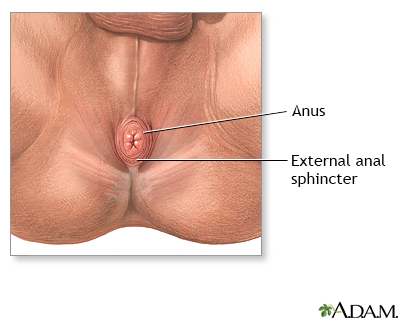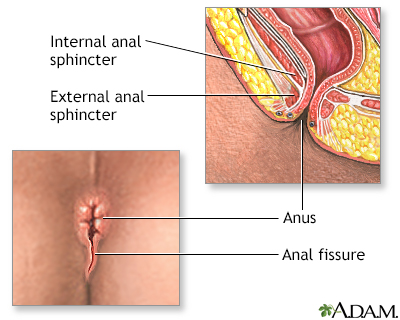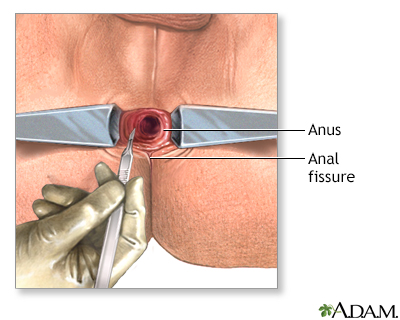Rectal bleeding
Rectal bleeding; Blood in the stool; Hematochezia; Lower gastrointestinal bleeding; MelenaRectal bleeding is when blood passes from the rectum or anus. Bleeding may be noted on the stool or be seen as blood on toilet paper or in the toilet. The blood may be bright red. The term "hematochezia" is used to describe this finding.
Considerations
The color of the blood in the stools may indicate the source of bleeding.
Black or tarry stools (melena) may be due to bleeding in the upper part of the GI (gastrointestinal) tract, such as the esophagus, stomach, or the first part of the small intestine. In this case, blood is most often darker because it gets digested on its way through the GI tract. Much less commonly, this type of bleeding can be brisk enough to present with bright red rectal bleeding.
Black or tarry stools
Black or tarry stools with a foul smell are a sign of a problem in the upper digestive tract. It most often indicates that there is bleeding in the ...

Bleeding from the rectum may also be red or fresh. This usually means that the source of bleeding is the lower GI tract (colon, rectum, and anus).
Eating beets or foods with red food coloring can sometimes make stools appear reddish. In these cases, your health care provider can test the stool with a chemical to check for the presence of blood.
Causes
Rectal bleeding causes include:
- Anal fissure (a cut or a tear in the anal lining, often caused by straining hard, hard stools or frequent diarrhea). It may cause sudden onset of rectal bleeding. There is most often pain at the anal opening.
Anal fissure
An anal fissure is a small split or tear in the thin moist tissue (mucosa) lining the lower rectum (anus).
 ImageRead Article Now Book Mark Article
ImageRead Article Now Book Mark Article - Hemorrhoids, a common cause of bright red blood. They may or may not be painful.
Hemorrhoids
Hemorrhoids are swollen veins in the anus or lower part of the rectum.
 ImageRead Article Now Book Mark Article
ImageRead Article Now Book Mark Article - Proctitis (inflammation or swelling of the rectum and anus).
Proctitis
Proctitis is an inflammation of the rectum. It can cause discomfort, bleeding, and the discharge of mucus or pus.
 ImageRead Article Now Book Mark Article
ImageRead Article Now Book Mark Article - Rectal prolapse (rectum protrudes from the anus).
Rectal prolapse
Rectal prolapse occurs when the rectum sags and comes through the anal opening.
 ImageRead Article Now Book Mark Article
ImageRead Article Now Book Mark Article - Trauma or foreign body.
- Colorectal polyps.
- Colon, rectal, or anal cancer.
- Ulcerative colitis and other types of colon inflammation (colitis)
Ulcerative colitis
Ulcerative colitis is a condition in which the lining of the large intestine (colon) and rectum become inflamed. It is a form of inflammatory bowel ...
 ImageRead Article Now Book Mark Article
ImageRead Article Now Book Mark Article - Infection in the intestines.
Infection in the intestines
Bacterial gastroenteritis occurs when there is a bacterial infection of your stomach or intestines.
 ImageRead Article Now Book Mark Article
ImageRead Article Now Book Mark Article - Diverticulosis (abnormal pouches in the colon).
Diverticulosis
Diverticula are small, bulging sacs or pouches that form on the inner wall of the intestine. Diverticulitis occurs when these pouches become inflame...
 ImageRead Article Now Book Mark Article
ImageRead Article Now Book Mark Article
When to Contact a Medical Professional
Contact your health care provider if there is:
- Fresh blood in your stools
- Abdominal pain associated with blood or bloody mucus in the stool
- A change in the color of your stools
- Pain in the anal area while sitting or passing stools
- Incontinence or lack of control over passage of stools
- Unexplained weight loss
- Drop in blood pressure that causes dizziness or fainting
You should see your provider and have an exam, even if you think that hemorrhoids are causing the blood in your stool.
In children, a small amount of blood in the stool is most often not serious. The most common cause is constipation. You should still tell your child's provider if you notice this problem.
What to Expect at Your Office Visit
Your provider will take a medical history and perform a physical exam. The exam will focus on your abdomen and rectum.
You may be asked the following questions:
- Have you had any trauma to the abdomen or rectum?
- Have you had more than one episode of blood in your stool? Is every stool this way?
- Have you lost any weight recently?
- Is there blood on the toilet paper only?
- What color is the stool?
- When did the problem develop?
- What other symptoms are present (abdominal pain, vomiting blood, bloating, excessive gas, diarrhea, or fever?
You may need to have one or more exams or tests to look for the cause:
- Digital rectal exam.
Digital rectal exam
A digital rectal exam is an exam of the lower rectum. Your health care provider uses a gloved, lubricated finger to check for any abnormal findings....
 ImageRead Article Now Book Mark Article
ImageRead Article Now Book Mark Article - Anoscopy.
- Sigmoidoscopy or colonoscopy to look inside your colon using a camera at the end of a thin tube to find or treat the source of bleeding may be needed.
Colonoscopy
A colonoscopy is an exam that views the inside of the colon (large intestine) and rectum, using a tool called a colonoscope. The colonoscope has a sm...
 ImageRead Article Now Book Mark Article
ImageRead Article Now Book Mark Article - Angiography.
Angiography
Mesenteric angiography is a test used to look at the blood vessels that supply the stomach, small and large intestines, and other internal organs. An...
 ImageRead Article Now Book Mark Article
ImageRead Article Now Book Mark Article - Bleeding scan.
Bleeding scan
An RBC nuclear scan uses small amounts of radioactive material (radioisotope) to mark (tag) red blood cells (RBCs). Your body is then scanned to see...
Read Article Now Book Mark Article
You may have one or more lab tests before, including:
- Complete blood count (CBC)
Complete blood count
A complete blood count (CBC) test measures the following:The number of white blood cells (WBC count)The number of red blood cells (RBC count)The numb...
 ImageRead Article Now Book Mark Article
ImageRead Article Now Book Mark Article - Serum chemistries
Serum chemistries
Electrolytes are minerals in your blood and other body fluids that carry an electric charge. Electrolytes affect how your body functions in many ways...
Read Article Now Book Mark Article - Clotting studies
- Stool culture or multiplex PCR test of stool to test for infection
Stool culture
A fecal culture is a lab test to find organisms in the stool (feces) that can cause gastrointestinal symptoms and disease.
 ImageRead Article Now Book Mark Article
ImageRead Article Now Book Mark Article
References
DeGeorge LM, Nable JV. Gastrointestinal bleeding. In: Walls RM, ed. Rosen's Emergency Medicine: Concepts and Clinical Practice. 10th ed. Philadelphia, PA: Elsevier; 2023:chap 26.
Kaplan GG, Ng SC. Epidemiology, pathogenesis, and diagnosis of inflammatory bowel diseases. In: Feldman M, Friedman LS, Brandt LJ, eds. Sleisenger and Fordtran's Gastrointestinal and Liver Disease. 11th ed. Philadelphia, PA: Elsevier; 2021:chap 115.
Kovacs TO, Jensen DM. Gastrointestinal hemorrhage. In: Goldman L, Cooney KA, eds. Goldman-Cecil Medicine. 27th ed. Philadelphia, PA: Elsevier; 2024:chap 121.
Kwaan MR. Hemorrhoids, anal fissure, and anorectal abscess and fistula. In: Kellerman RD, Rakel DP, Heidelbaugh JJ, Lee EM, eds. Conn's Current Therapy 2024. Philadelphia, PA: Elsevier; 2024:233-237
Savides TJ, Jensen DM. Gastrointestinal bleeding. In: Feldman M, Friedman LS, Brandt LJ, eds. Sleisenger and Fordtran's Gastrointestinal and Liver Disease. 11th ed. Philadelphia, PA: Elsevier; 2021:chap 20.
Swartz MH. The abdomen. In: Swartz MH, ed. Textbook of Physical Diagnosis: History and Examination. 8th ed. Philadelphia, PA: Elsevier; 2021:chap 17.
Anal fissure - series
Presentation
Hemorrhoids - illustration
The most common causes of hemorrhoids are straining at bowel movements, prolonged sitting and pregnancy. Internal hemorrhoids occur above the anal sphincter, and external hemorrhoids occur below, outside the anal canal.
Hemorrhoids
illustration
Colonoscopy - illustration
There are 3 basic tests for colon cancer; a stool test (to check for blood), sigmoidoscopy (inspection of the lower colon), and colonoscopy (inspection of the entire colon). All 3 are effective in catching cancers in the early stages, when treatment is most beneficial.
Colonoscopy
illustration
Anal fissure - series
Presentation
Hemorrhoids - illustration
The most common causes of hemorrhoids are straining at bowel movements, prolonged sitting and pregnancy. Internal hemorrhoids occur above the anal sphincter, and external hemorrhoids occur below, outside the anal canal.
Hemorrhoids
illustration
Colonoscopy - illustration
There are 3 basic tests for colon cancer; a stool test (to check for blood), sigmoidoscopy (inspection of the lower colon), and colonoscopy (inspection of the entire colon). All 3 are effective in catching cancers in the early stages, when treatment is most beneficial.
Colonoscopy
illustration
Review Date: 6/11/2024
Reviewed By: Jenifer K. Lehrer, MD, Department of Gastroenterology, Aria - Jefferson Health Torresdale, Jefferson Digestive Diseases Network, Philadelphia, PA. Review provided by VeriMed Healthcare Network. Also reviewed by David C. Dugdale, MD, Medical Director, Brenda Conaway, Editorial Director, and the A.D.A.M. Editorial team.










